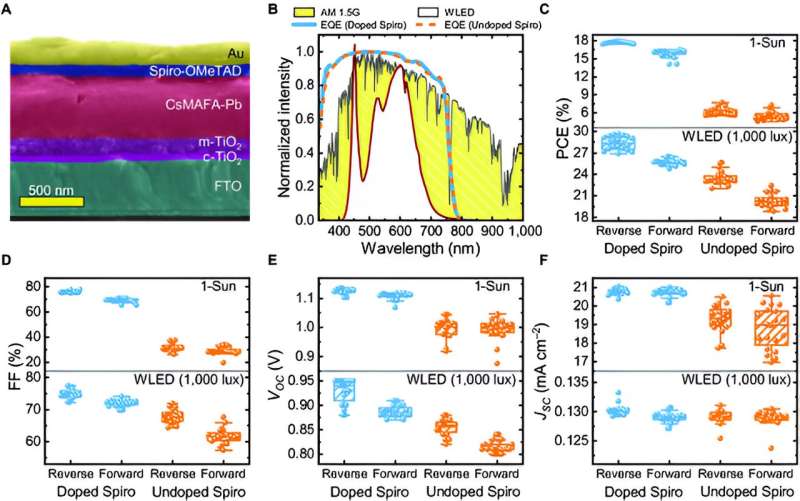This article has been reviewed according to Science X's editorial process and policies. Editors have highlighted the following attributes while ensuring the content's credibility:
fact-checked
proofread
Is doping of Spiro-OMeTAD a requirement for efficient and stable perovskite indoor photovoltaics?

In this work, researchers studied the outdoor and indoor photovoltaic performance of LHP-based devices utilizing Spiro-OMeTAD as the hole-transport material with commonly used dopants such as lithium bis(trifluoromethanesulfonyl)imide (Li-TFSI) or without any dopants.
The researchers find out that, despite the expected low performance of devices employing undoped Spiro-OMeTAD layer under 1-Sun illumination (up to 7.7% efficiency), the devices achieve up to 25.6% efficiency under 1000 lux illumination, which is comparable to the doped counterpart devices achieving up to 29.7% efficiency. This is mainly due to the major improvement in fill factor when going towards low-light intensities, which can be explained by the diminished effect of series resistance under indoor lighting.
The operational stability of the devices was also tested. When kept under continuous white light illumination, undoped Spiro-OMeTAD devices also show ≈25% increase in maximum power point efficiency, thus potentially surpassing the performance of doped Spiro-OMeTAD devices. Undoped Spiro-OMeTAD devices also have lower hysteresis at very low-light levels and an open-circuit voltage of ≈0.65 V at 50 lux, thus making them more reliable in these conditions.
This work proposes that, despite the requirement of doped Spiro-OMeTAD to achieve high-performing LHP-based solar cells, the dopants may not be necessary to fabricate indoor photovoltaics that work reliably under low-light intensities with high efficiency and stability.
The results also show that the efficiency of LHP-based solar cells do not predict their performance under low-light conditions. Thus, the photovoltaic structure should be fine-tuned for the intended lighting source of the device to achieve the optimal performance.
More information: Sami Toikkonen et al, Is Doping of Spiro-OMeTAD a Requirement for Efficient and Stable Perovskite Indoor Photovoltaics?, Advanced Devices & Instrumentation (2024). DOI: 10.34133/adi.0048


















